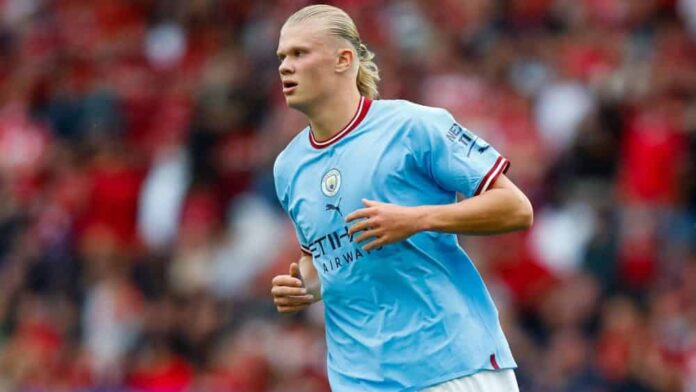All eyes were on Erling Haaland on his competitive debut for Manchester City. Did the new signing, who arrived from Dortmund, impress in Leicester’s 3-1 Community Shield defeat to Liverpool FC? Or disappointed? Here’s the first Haaland analysis of the season.
The final goal was a real cracker. But a battening down the hatches. Sounds spectacular, but it wasn’t good either, because Erling Haaland should have put the ball in Liverpool FC’s goal in the seventh minute of stoppage time, but after a flat pass he only hit the aluminium from close range when free. It would have been 2:3, a goal of no value, because it would not have changed the defeat of the champions against the FA Cup winners. And yet the Norwegian himself could have left the pitch feeling a little better – now it’s a little worse.
Because Haaland generally did not have a good day. Of course, that doesn’t have to be overrated at this point of the season, but the 75-million-euro man will need some time to get used to the Cityzens’ game, as could definitely be seen against this strong opponent.
That is not surprising, but it is remarkable how Haaland increased the miss rate of his new team in the first game. Not because he played an extremely high number himself, but because he kept looking for the way deep. That is legitimate because it is one of the strengths of this brawny nine-man. But it is not City’s game to send a nine deep. It was often the case that a nine – whether real or false is secondary in this case – broke away from the last chain to the back, dragged centre-backs along and created spaces in which the incoming eights or wingers were given slot balls.
Now Haaland himself demanded this interface ball, but it was here that Liverpool’s Joel Matip and Virgil van Dijk or even Thiago one step further forward decisively put their foot in front or in between. As a result, many balls that had previously remained safely in City’s possession did not arrive. And that’s what Pep Guardiola is all about: possession, control. Playing passes that you don’t know 90 per cent that they will arrive is not something this coach, who shies away from risk and has perfected positional play for precisely that reason, likes to do.
Does Haaland adapt?
This will be exciting to watch over the coming weeks: Does Haaland adapt? Or will Guardiola allow compromises? The latter is hard to imagine. Let’s wait and see.
Haaland did not wait at all to start the game, after only a few seconds he was already using his body robustly against none other than van Dijk. This will undoubtedly be a new element in the game of the English champions. Apart from the aforementioned chance just before closing time, Haaland had also missed a good one in the first half. Here he gave himself space and advantage against Andy Robertson with his force, but failed to beat Reds keeper Adrian.
There was little sign of Haaland for long periods in the second half, and he had no part in Julian Alvarez’s only goal – the substitute newcomer scored in contrast to the Norwegian.
Darwin bigger than Haaland?
Liverpool’s new boy Darwin stole the show, though, and although only in a wild card role, gave everyone a taste of how the double cup winners will look to replace Sadio Mané (FC Bayern): with force, with gall and, as is Liverpool’s way, as a collective
City, meanwhile, could be put to the test by Haaland, as Kevin De Bruyne and the centre-forward did not harmonise very well either. But that can still happen. But often Haaland, more active with the ball than in counter-pressing, should not remain demonstratively offside. That made De Bruyne angry. And Guardiola will not have been “amused” either.







